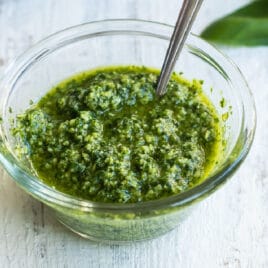
Basil Pesto
Turn your summer basil bumper crop into Basil Pesto and freeze it for colder days ahead. It's easy to make and ready in 10 minutes or less.
Servings 8 servings (2 tbsp each)
Calories 166kcal
Ingredients
- 2 cups fresh basil leaves packed
- 1 cup fresh parsley packed (see note 1)
- 1/4 cup Parmesan cheese grated
- 1/4 cup pine nuts (see note 2)
- 3 cloves garlic (see note 3)
- 1/2 cup olive oil
- Salt and freshly ground black pepper
Instructions
- In a food processor or blender, add basil, parsley, Parmesan cheese, pine nuts, and garlic. Pulse until coarsely chopped, about 10 pulses.
- With the motor running, slowly drizzle in the olive oil and process until smooth. Season to taste with salt and pepper.
Notes
- Parsley: A handful of fresh parsley ensures that your pesto is always bright green (basil can dark when it gets bruised).
- Pine nuts: For more flavor, toast the pine nuts. In a medium skillet over medium heat, heat pine nuts until browned and fragrant, stirring occasionally, about 2 to 5 minutes.
- Garlic: Soften its raw taste by roasting garlic. In a dry medium skillet over medium-low heat, toast unpeeled garlic cloves until spotty, dark brown, and slightly softened, about 20 to 25 minutes. Cool completely before peeling.
- Yield:This recipe makes 1 cup of pesto, enough for 1 pound of pasta or 8 servings, 2 tablespoons each.
- Storage: Store covered in the refrigerator for up to 4 days. Add a layer of olive oil on top to prevent oxidation.
Nutrition
Serving: 2 tbsp | Calories: 166kcal | Carbohydrates: 2g | Protein: 2g | Fat: 17g | Saturated Fat: 3g | Cholesterol: 2mg | Sodium: 55mg | Potassium: 92mg | Fiber: 1g | Sugar: 1g | Vitamin A: 974IU | Vitamin C: 11mg | Calcium: 61mg | Iron: 1mg